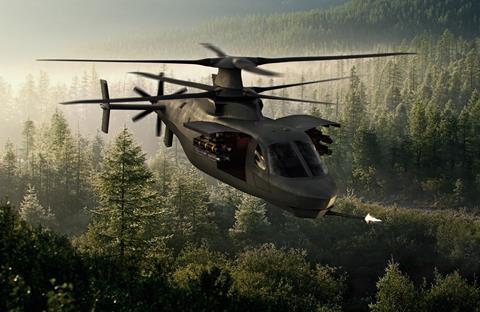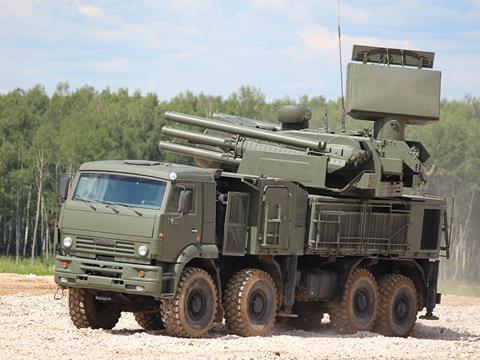The US Army thinks it has found a weak spot in the air defences of Russia and China.
And just like Achilles’ heel, this vulnerability is down low. In particular, the service believes the lower tier air defences of its major adversaries have a soft spot.

When it comes to invading other countries, the kick-in-the-door, wipe-out-the-air-defence missions are typically handed out to the US Air Force (USAF) and its fleet of stealthy aircraft. The US Army, with its brown fatigues, tanks and helicopters, usually arrives later, after the enemy’s air defences, communications networks and air force have been destroyed.
However, the service believes it should play a leading role in the suppression of enemy air defences. It contends that new rotorcraft technologies give it an advantage that its brethren in the USAF lack.
“The lower tier of the air domain is, in fact, decisive,” says Brigadier General Walter Rugen, director of the US Army’s Future Vertical Lift Cross Functional Team. “We don’t have a problem that the high flyers do. We can hide in the clutter, show up at the time and place of our choosing to really create chaos in the enemy’s decision cycle.”
The US Army believes it can use terrain masking – that is, hiding from radar behind hills and in valleys – more effectively than it ever has before. Using innovative flight controls that automate parts of nap-of-the-earth flight, the service thinks it can fly its Future Attack Reconnaissance Aircraft (FARA) at speeds that are higher and altitudes that are lower than previously thought possible or safe.
“We’re being very innovative in that space. Very, very innovative on how low we can get, how fast we can get,” says Rugen. “And so far, it’s working out. We’ve done a ton of runs.”
Using army rotorcraft to attack air defence systems is not unprecedented. At the outset of 1991’s Desert Storm operation to liberate Kuwait, Boeing AH-64 Apaches were employed to fly in low and destroy Iraqi radar sites. This created a coverage gap that fixed-wing aircraft exploited.
NAP-OF-THE-EARTH STEALH
The US Army’s claims come as the USAF’s, US Navy’s and US Marine Corps’ Lockheed Martin F-35 Lightning IIs, and other low-observable strike aircraft, are up against increasingly sophisticated and lethal air defences. In particular, US war planners worry about the Russian-built S-400 Triumf surface-to-air-missile system, which Moscow claims has anti-stealth capabilities.
That battery can hit aerial targets at ranges up to 135nm (250km), with a future missile upgrade possibly expanding its reach to 216nm, according to think tank the Center for Strategic and International Studies (CSIS). After Turkey bought and received the missile system from Russia in 2019, Washington ejected its NATO ally from the F-35 programme, saying the stealth fighter could be compromised.

Still, the S-400 has a problem. The weapon is optimised for hitting high flying aircraft and needs protection from low-flying threats such as loitering munitions, cruise missiles or helicopters, says Ian Williams, deputy director of the CSIS’s Missile Defense Project. To shield it from low-altitude weapons, the Russian military typically surrounds the S-400 with short-range air defence systems, such as the Pantsir-S1 gun and missile battery. “They always co-locate them with their longer range air defences, in order to protect them from these kinds of threats,” Williams says.
In fact, the Pantsir-S1, known also by its NATO reporting name SA-22 Greyhound, is exactly the type of threat the US Army is eager to take on with FARA , which is scheduled to be fielded by 2028.
“In the penetration phase for Future Vertical Lift, we’re certainly going after SA-22s with our advanced ingress tactics, techniques and procedures that we’re developing,” says Rugen. “We then go after command and control vehicles. We then go after enemy long range fires capability.”
The US Army wants FARA to be a nimble “knife fighter” that will duck and weave between enemy air defences. It is to have a cruise speed of at least 180kt (333km/h) and a rotor diameter no greater than 12.2m (40ft). The small helicopter is expected to not only hide behind hills, but between high-rise buildings in megacities.
Nonetheless, hiding behind terra firma – or even between structures – is not a new concept. During the Cold War, the variable swept wing Rockwell B-1 Lancer bomber was designed to fly low to the ground to avoid detection from radar-guided missiles on hypothetical nuclear strikes against the USSR.
The B-1B fell out of favour for penetrating strikes when it was discovered in the late 1970s that Moscow was developing a look down/shoot down radar. Such radar would allow a higher-flying aircraft to spot incoming, low flying bombers against the backdrop of the earth without confusing the aircraft with objects on the ground. Hence, the penetration and suppression of enemy defence mission was handed off to stealth aircraft, starting with the Lockheed F-117 Nighthawk.
In the same way that the B-1B was exposed to look down/shoot down radar, it would seem that a helicopter with its many radar-reflecting angles, including main and tail rotors, would be highly vulnerable.
Not so, says Rugen. Instead, the US Army believes FARA can conceal itself by flying extremely low to the ground – far lower than jet aircraft are capable. Rugen declines to say how low and fast its next-generation scout helicopter will be able to fly, citing classification restrictions, but reiterates that the service’s “high fidelity model” shows the lower tier of the air domain is “decisive”.
“It’s much easier [to be spotted] when the air is clear and clean, higher than, depending on where you are, 300ft, 1,000ft or 3,000ft above [the ground],” says Rugen. “It’s very anecdotal to say that they can look down and shoot down. I have seen very little reporting on the ability to do that, if any. And, I’ve not seen any model or test that has been able to show that they can do that as routinely as they can with people who operate in the upper tier air domain.”
Distinguishing FARA from the ground, a building or a moving vehicle would be difficult, he says. “There’s a lot of clutter. A milk truck is clutter, right? Some of our stuff is just flying as slow as a milk truck,” says Rugen. “There’s a lot to sort out. I don’t know that anybody’s got an algorithm to do that.”
Nonetheless, the danger to FARA is that pilots might accidentally step out from the radar shadows and alert the enemy to their presence. “If we poke our head up too high, we’re in trouble,” says Rugen. “But that’s where a lot of this cognitive offloading work we’re doing [comes in], to make sure we can fly as fast as we possibly can, as low as we possibly can.”
The US Army is working on several initiatives to make it easier for FARA pilots to fly low. For instance, its “Holistic Situational Awareness – Decision Making” development programme, which is to launch in fiscal year 2021, is looking for data fusion technologies to simplify in-bound cockpit information and make it easier for pilots to make decisions, says a service request for information posted in April.
Moreover, Bell and Sikorsky’s proposals for the FARA programme are fly-by-wire rotorcraft that they say can be optionally piloted, meaning the aircraft’s flight computers should be capable of some precision autonomous flight without a pilot’s hand on the stick. Bell is building the 360 Invictus, a winged helicopter with ducted tail rotor and a booster auxiliary power unit; and Sikorsky is building the Raider X, a co-axial compound helicopter with a pusher propeller.
Rugen declines to discuss how automated nap-of-the-earth flight would work or to name the companies working on the FARA subsystems. It is also not clear to what extent such tricky manoeuvres would be automated.
In fact, entrusting a helicopter to fly itself at high speeds, low-to-the-ground and in-between obstacles is an enormous engineering task. Just avoiding power lines, mortal enemy No. 1 for helicopters everywhere, requires the constant attention of pilots.
Yet, the US Army wants to free pilots from the burdens of flying. In April, the service put out a request for information about potential mission systems for FARA. It requested sensors covering a 360° field of view for flying the helicopter in degraded visual environments, by day or night. Such sensors must be capable of detecting wires and obstacles in low light, as well as avoiding collision with terrain. “The FARA [project manager] is also interested in solutions and software applications that support supervised autonomy and optionally-manned flight,” says the request for information.
Recently, the service practiced using an undisclosed software to automatically reroute helicopters around bad weather and threats, says Rugen of the August and September “Project Convergence” exercises at Yuma Proving Grounds in Arizona. “Flying [and] ingressing, a lot of that is going to be automated because we understand the terrain. We understand what’s going to reach up and maybe impact us in the terrain,” he says.
LONG-RANGE STRIKE
Penetrating Russia or China’s air space will require more than just terrain-masking flight techniques, however. Both countries have layered missile defences, which include not only radar-guided short-range missile batteries, but also easy-to-hide man-portable air-defence systems (MANPADS), such as shoulder-fired surface-to-air missiles.
To avoid line-of-sight weapons, such as heat-seeking missiles fired from MANPADS, “rotorcraft would operate in relative sanctuary just outside the enemy’s weapon engagement zone and flood the zone with air launched effects pushing forward to detect, identify, locate and report [the most-dangerous] threats that would then be targeted and engaged using long-range precision munitions,” says Rugen.
Air launched effects are a form of unmanned air vehicle (UAV) that the service envisions launching from FARA and the General Atomics Aeronautical Systems MQ-1C Gray Eagle UAV. The US Army wants FARA to hide in the clutter of the terrain and to use air launched effects to peek behind enemy lines. The small tube-launched drones would be used for intelligence, surveillance and reconnaissance, electronic warfare, decoy and loitering munition strike missions.
Air launched effects could drastically increase the sight and striking range of FARA and could be networked together to pass back information. “We’ve had our air launched effects daisy chained out to about 61km,” says Rugen of exercises with Area-I drones at Project Convergence.
Once a target is spotted, via an air launched effect, MQ-1C or FARA, the service wants any soldier, helicopter pilot, artillery man or UAV operator with a weapon in range to strike (hence the exercise’s name Project Convergence). During the recent exercises in Yuma, the US Army passed targeting information around the battlefield using TrellisWare software-defined radios and hardened tablet computers.
The US Army also aims to speed up the process by which targets are spotted and attacked. It is quickening the process in exercises using an artificially intelligent program. “We are working with our ground partners to have simultaneous execution of targets at extremely quick speed facilitated by some software we call Firestorm that distributes target [data] to the right shooter,” says Rugen.
Firestorm is even capable of automating Lockheed AGM-114 Hellfire air-to-surface missile shots from the MQ-1C. “If determined to be the best shooter, Gray Eagle is assigned the fire mission, software on board the Gray Eagle automatically calculates the route and munitions needed to engage the target and sends this back to the ground commander, who must approve,” says Rugen. “Then, the Gray Eagle flies itself into position and executes the fire mission with no further inputs.”
Ultimately, the US Army believes this sort of automation will give it an edge.
“It’s really refining our kill chain down, taking them from minutes to seconds,” says Rugen.



























